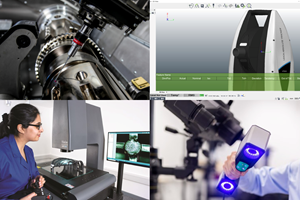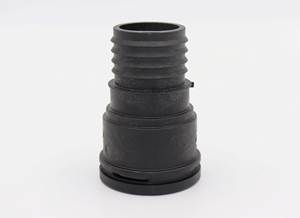Share
Renishaw will launch its SPRINT™ high-speed analogue contact scanning system for CNC machine tools, in autumn 2013. The SPRINT system incorporates a new generation of on-machine analogue scanning technology that will deliver a step-change in the benefits of process control, enabling fast and accurate form and profile data capture from both prismatic and complex 3D components.
Drawing on Renishaw's partnerships with major businesses in key industrial sectors, the SPRINT machine tool scanning system has been designed to provide a game-changing capability for high value CNC manufacturing processes.
For blade manufacture, the SPRINT system provides unprecedented capability for blade tip refurbishment and root blending applications, the company states. The high-speed measurement of blade sections coupled with high data integrity (even on leading and trailing edges) ensures the indication of true part condition leading to an adaptive machining capability. Automated routines, such as set-up, blade alignment, blade scanning and data collection result in significant accuracy and cycle time improvements over touch-trigger systems, according to the company.
For multi-task machining applications, the SPRINT machine tool scanning system offers users completely new process control capabilities, including exceptionally repeatable diameter measurement cycles, the company states. By employing master part comparison, the SPRINT system becomes an “active” control—enabling measure-cut processes to be automated for accurate diameters on large parts. This capability can result in the size of diameters being automatically controlled to within a few microns of tolerance. Measurement functionality such as part run out, machine centerline and circularity, also serves to significantly enhance the manufacturing capability of multi-tasking machine tools, according to the company.
Additional functionality offered by the SPRINT system provides a rapid health-check of a CNC machine tool's linear and rotary axes in seconds, making it possible to implement a daily machine monitoring regime with little or no operator involvement.
Each SPRINT application is enabled and supported by a software toolkit package, which is dedicated to a specific industrial task, for example, the SPRINT blade toolkit. The toolkits include on-machine data analysis tools which run automatically in-cycle and provide measurement feedback to a CNC machining process.
At the core of the SPRINT system is the revolutionary OSP60 scanning probe. The OSP60 probe has an analogue sensor with 0.1 μm resolution in three dimensions, providing exceptional accuracy and the greatest understanding of workpiece form. The analogue sensor technology in the probe provides a continuous deflection output that is combined with machine position to derive the true location of the part surface. Measuring 1000 true 3D data points per second, the system's superior analytical capabilities provide unparalleled opportunities for workpiece measurement, inspection, adaptive machining and on-machine process control, whilst optimizing machine utilization and cycle time. This new scanning technology opens up new process control methods not previously possible with other measurement methods, according to the company.
In parallel to extremely fast and accurate 3D measurement the SPRINT analogue scanning system has also been designed to facilitate automated process control with no requirement for operator intervention.
Incorporating multiple patented technologies, the SPRINT system enables unrivalled high-speed, high-accuracy 3D surface data collection through powerful compensation of the static and dynamic volumetric errors which are often associated with high-speed machine movement.
The SPRINT system is a ground-breaking high-speed, high-accuracy tool with an exceptional range of potential applications, enabling a wide range of measurement and process control methods, reducing scrap and rework, while increasing machine capacity by reducing measurement cycle times.
Related Content
Software Strategy for Automated Mold Inspection
Consider inspection software with a CAD/CAM platform that supports model-based definition, works with all CAD files, and drives all fixed and portable CMMs.
Read MoreQuality Control Technologies Geared for Injection Molds
These latest technology solutions, from noncontact gages to test probes and automated inspection systems, aim to minimize production risks and ensure optimal quality control practices for moldmaking.
Read MoreHow to Harness 3D Scanning for Mold Tool Repairs
3D scanning supports the repair of molds with no history, drawings or design files.
Read MoreVIDEO: Maintaining a Customer-Centric Culture
Progressive Components President Glenn Starkey talks about the importance of the customer and culture when developing technology solutions for the moldmaking industry.
Read MoreRead Next
How to Use Continuing Education to Remain Competitive in Moldmaking
Continued training helps moldmakers make tooling decisions and properly use the latest cutting tool to efficiently machine high-quality molds.
Read MoreAre You a Moldmaker Considering 3D Printing? Consider the 3D Printing Workshop at NPE2024
Presentations will cover 3D printing for mold tooling, material innovation, product development, bridge production and full-scale, high-volume additive manufacturing.
Read MoreHow to Use Strategic Planning Tools, Data to Manage the Human Side of Business
Q&A with Marion Wells, MMT EAB member and founder of Human Asset Management.
Read More




















